 W
WChinese dictionaries date back over two millennia to the Han Dynasty, which is a significantly longer lexicographical history than any other language. There are hundreds of dictionaries for the Chinese language, and this article discusses some of the most important.
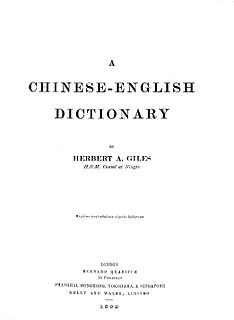 W
WA Chinese–English Dictionary (1892), compiled by the British consular officer and sinologist Herbert Allen Giles (1845–1935), is the first Chinese–English encyclopedic dictionary. Giles started compilation after being rebuked for criticizing mistranslations in Samuel Wells Williams' (1874) A Syllabic Dictionary of the Chinese Language. The 1,461-page first edition contains 13,848 Chinese character head entries alphabetically collated by Beijing Mandarin pronunciation romanized in the Wade–Giles system, which Giles created as a modification of Thomas Wade's (1867) system. Giles' dictionary furthermore gives pronunciations from nine regional varieties of Chinese, and three Sino-Xenic languages Japanese, Korean, and Vietnamese. Giles revised his dictionary into the 1,813-page second edition (1912) with the addition of 67 entries and numerous usage examples.
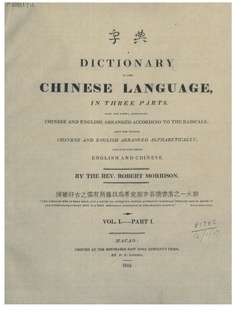 W
WA Dictionary of the Chinese Language, in Three Parts or Morrison's Chinese dictionary (1815-1823), compiled by the Anglo-Scottish missionary Robert Morrison was the first Chinese-English, English-Chinese dictionary. Part I is Chinese-English arranged by the 214 Kangxi radicals, Part II is Chinese-English arranged alphabetically, and Part III is English-Chinese also arranged alphabetically. This groundbreaking reference work is enormous, comprising 4,595 pages in 6 quarto volumes and including 47,035 head characters taken from the 1716 Kangxi Dictionary. However, Morrison's encyclopedic dictionary had flaws, notably failing to distinguish aspirated consonants: the pronunciation taou is given for both aspirated táo and unaspirated dào.
 W
WA Syllabic Dictionary of the Chinese Language: Arranged According to the Wu-Fang Yuen Yin, with the Pronunciation of the Characters as Heard in Peking, Canton, Amoy, and Shanghai or the Hàn-Yīng yùnfǔ 漢英韻府 (1874), compiled by the American sinologist and missionary Samuel Wells Williams, is a 1,150-page bilingual dictionary including 10,940 character headword entries, alphabetically collated under 522 syllables. Williams' dictionary includes, in addition to Mandarin, Chinese variants from Middle Chinese and four regional varieties of Chinese, according to the 17th-century Wufang yuanyin 五方元音 "Proto-sounds of Speech in All Directions".
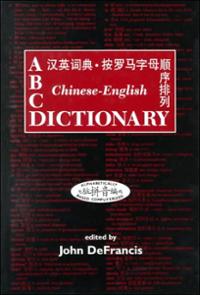 W
WThe ABC Chinese–English Dictionary or ABC Dictionary (1996), compiled under the chief editorship of John DeFrancis, is the first Chinese dictionary to collate entries in single-sort alphabetical order of pinyin romanization, and a landmark in the history of Chinese lexicography. It was also the first publication in the University of Hawai'i Press's "ABC" series of Chinese dictionaries. They republished the ABC Chinese–English Dictionary in a pocket edition (1999) and desktop reference edition (2000), as well as the expanded ABC Chinese–English Comprehensive Dictionary (2003) and dual ABC Chinese–English/English-Chinese Dictionary (2010). Furthermore, the ABC Dictionary databases have been developed into computer applications such as Wenlin Software for learning Chinese (1997).
 W
WThe CFDICT project was started by David Houstin in 2010 and is maintained by a team on Chine Informations, with the aim to provide a complete Chinese to French dictionary with pronunciation in pinyin for the Chinese characters.
 W
WThe Concise Dictionary of Spoken Chinese (1947), which was compiled by Yuen Ren Chao and Lien Sheng Yang, made numerous important lexicographic innovations. It was the first Chinese dictionary specifically for spoken Chinese words rather than for written Chinese characters, and one of the first to mark characters for being "free" or "bound" morphemes according to whether or not they can stand alone as a complete and independent utterance.
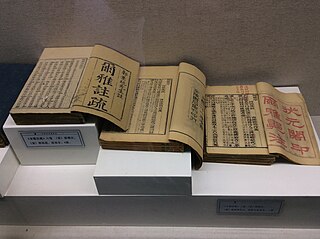 W
WThe Erya or Erh-ya is the first surviving Chinese dictionary. Bernhard Karlgren concluded that "the major part of its glosses must reasonably date from the 3rd century BC."
 W
WGanlu Zishu is a Chinese orthography dictionary of the Tang Dynasty. The first surviving orthographical dictionary for the regular script, it was authored by Yan Yuansun (顏元孫), a descendant of the famous scholar Yan Shigu. It is roughly based on Yan Shigu's work Ziyang, now surviving only in fragments. It was meant to be an official guide for the use of those who took the Imperial examination, thus the title "Ganlu", an allusion to the Analects (2:18).
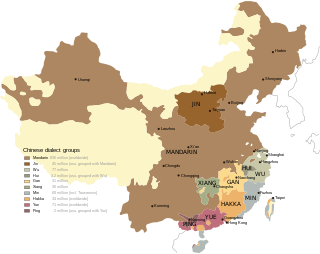 W
WThe Great Dictionary of Modern Chinese Dialects is a compendium of dictionaries for 42 local varieties of Chinese following a common format. The individual dictionaries cover dialects spread across the dialect groups identified in the Language Atlas of China:Mandarin Northeastern Mandarin: Harbin dialect Ji–Lu Mandarin: Jinan dialect Jiao–Liao Mandarin: Muping dialect Central Plains Mandarin: Luoyang dialect, Wanrong dialect, Xi'an dialect, Xining dialect, Xuzhou dialect Lanyin Mandarin: Urumqi dialect, Yinchuan dialect Southwestern Mandarin: Chengdu dialect, Guiyang dialect, Liuzhou dialect, Wuhan dialect Lower Yangtze Mandarin: Nanjing dialect, Yangzhou dialect Jin: Taiyuan dialect, Xinzhou dialect Wu: Chongming dialect, Danyang dialect, Hangzhou dialect, Jinhua dialect, Ningbo dialect, Shanghai dialect, Suzhou dialect, Wenzhou dialect Hui: Jixi dialect Gan: Lichuan dialect, Nanchang dialect, Pingxiang dialect Xiang: Changsha dialect, Loudi dialect Min: Fuzhou dialect, Haikou dialect, Jian'ou dialect, Leizhou dialect, Xiamen dialect Yue: Dongguan dialect, Guangzhou dialect Hakka: Meixian dialect, Yudu dialect Pinghua: Nanning dialect
 W
WThe Guangyun is a Chinese rime dictionary that was compiled from 1007 to 1008 under the patronage of Emperor Zhenzong of Song. Its full name was Dà Sòng chóngxiū guǎngyùn. Chen Pengnian and Qiu Yong (邱雍) were the chief editors.
 W
WGwoyeu Romatzyh, abbreviated GR, is a system for writing Mandarin Chinese in the Latin alphabet. The system was conceived by Yuen Ren Chao and developed by a group of linguists including Chao and Lin Yutang from 1925 to 1926. Chao himself later published influential works in linguistics using GR. In addition a small number of other textbooks and dictionaries in GR were published in Hong Kong and overseas from 1942 to 2000.
 W
WHan-Han Dae Sajeon is the generic term for Korean hanja-to-hangul dictionaries. There are several such dictionaries from different publishers. The most comprehensive one, published by Dankook University Publishing, contains 53,667 Chinese characters and 420,269 compound words. This dictionary was a project of the Dankook University Institute of Oriental Studies, which started in June 1977 and was completed 28 October 2008, and cost 31 billion KRW, or US$25 million. The dictionary comprises 16 volumes totalling over 20,000 pages.
 W
WThe Hanyu Da Cidian is the most inclusive available Chinese dictionary. Lexicographically comparable to the Oxford English Dictionary, it has diachronic coverage of the Chinese language, and traces usage over three millennia from Chinese classic texts to modern slang. The chief editor Luo Zhufeng (羅竹風) (1911–1996), along with a team of over 300 scholars and lexicographers, started the enormous task of compilation in 1979. Publication of the thirteen volumes began with first volume in 1986 and ended with the appendix and index volume in 1994.
 W
WThe Hanyu dazidian is a reference work on Chinese characters.
 W
WThe Jijiupian 急就篇, which was compiled by Han dynasty scholar Shi You 史游, was a Chinese primer and a prototype for Chinese dictionaries. This Chinese character abecedarium contains a series of orthographic word lists, categorized according to character radical, and briefly explained in rhymed lines. In the Qin and Han dynasties, several similar othographic primers were in circulation, such as Cangjiepian, but the Jijiupian is the only one that survived for two millennia.
 W
WJingdian Shiwen, often abbreviated as Shiwen in Chinese philological literature, was a c. 583 exegetical dictionary or glossary, edited by the Tang dynasty classical scholar Lu Deming. Based on the works of 230 scholars during the Han, Wei, and Six Dynasties periods, this Chinese dictionary analyzes the pronunciations and meanings of terms in the Confucian Thirteen Classics and the Daoist Daodejing and Zhuang Zi. It also cites some ancient books that are no longer extant, and are only known through Jingdian Shiwen.
 W
WThe Kangxi Dictionary was the standard Chinese dictionary during the 18th and 19th centuries. The Kangxi Emperor of Qing Dynasty ordered its compilation in 1710. It used the earlier Zihui system of 214 radicals, today known as 214 Kangxi radicals, and was published in 1716. The dictionary is named after the Emperor's era name.
 W
WThe 214 Kangxi radicals, also known as the Zihui radicals, form a system of radicals (部首) of Chinese characters. The radicals are numbered in stroke count order. They are the most popular system of radicals for dictionaries that order Traditional Chinese characters by radical and stroke count. They are officially part of the Unicode encoding system for CJKV characters, in their standard order, under the coding block "Kangxi radicals", while their graphic variants are contained in the "CJK Radicals Supplement". Thus, a reference to "radical 61", for example, without additional context, refers to the 61st radical of the Kangxi Dictionary, 心; xīn "heart".
 W
WThe (1066) Leipian 類篇 is a Chinese dictionary compiled by Song dynasty (960-1279) lexicographers under the supervision of chancellor Sima Guang. It contains 31,319 character head entries, more than twice as many as the 12,158 in the Yupian, and included many new characters created during the Tang (618-907) and Song dynasties. Leipian entries are arranged by a 544-radical system adapted from the 540 radicals of the classic (121) Shuowen Jiezi.
 W
WLin Yutang's Chinese-English Dictionary of Modern Usage (1972), compiled by the linguist and author Lin Yutang, contains over 8,100 character head entries and 110,000 words and phrases, including many neologisms. Lin's dictionary made two lexicographical innovations, neither of which became widely used. Collation is based on his graphical "Instant Index System" that assigns numbers to Chinese characters based on 33 basic calligraphic stroke patterns. Romanization of Chinese is by Lin's "Simplified National Romanization System", which he developed as a prototype for the Gwoyeu Romatzyh or "National Romanization" system adopted by the Chinese government in 1928. Lin's bilingual dictionary continues to be used in the present day, particularly the free online version that the Chinese University of Hong Kong established in 1999.
 W
WThe list of Shuowen Jiezi radicals consists of the 540 radicals used to structure the Shuowen Jiezi, created by lexicographer Xu Shen. The 540 radicals are shown below.
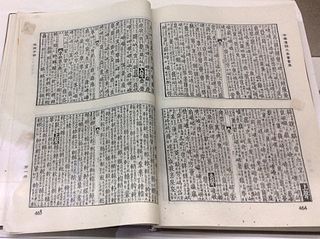 W
WLongkan Shoujian is a Chinese dictionary compiled during the Liao Dynasty by the Khitan monk Xingjun (行均). Completed in 997, the work had originally been entitled Longkan Shoujing, but had its title changed owing to naming taboo when it was later printed by the Song publishers. The earliest surviving edition of the work is an incomplete Korean one, reprinted in China in 1985.
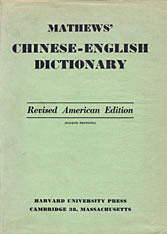 W
WA Chinese–English Dictionary: Compiled for the China Inland Mission by R. H. Mathews (1931) or Mathews' Chinese–English Dictionary (1943), edited by the Australian Congregationalist missionary Robert Henry Mathews (1877-1970), was the standard Chinese–English dictionary for decades. Mathews originally intended his dictionary to be a revision of Frederick W. Baller's out-of-print (1900) An Analytical Chinese–English Dictionary, Compiled for the China Inland Mission, but ended up compiling a new dictionary. Mathews copied, without acknowledgment, from Herbert Allen Giles' A Chinese–English Dictionary.
 W
WThe Chinese and English Dictionary: Containing All the Words in the Chinese Imperial Dictionary, Arranged According to the Radicals (1842), compiled by the English Congregationalist missionary Walter Henry Medhurst (1796-1857), is the second major Chinese-English dictionary after Robert Morrison's pioneering (1815-1823) A Dictionary of the Chinese Language. Medhurst's intention was to publish an abridged and cheaper dictionary that still contained all the 47,035 head characters from the (1716) Kangxi Dictionary, which Morrison's huge dictionary included. Medhurst reversed and revised into his Chinese-English dictionary in compiling the (1847-1848) English and Chinese Dictionary in Two Volumes.
 W
WThe Pearl in the Palm or the Timely Pearl is a bilingual glossary between the Chinese and Tangut languages. It survives as a single complete copy of a 12th-century woodblock printed book that was discovered in the Tangut city of Kharakhoto. In addition, a single page from a different copy of the same edition of the Pearl in the Palm was found at the Northern Mogao Caves in 1989. The book transcribes the pronunciation of Chinese words into Tangut characters, and the pronunciation of Tangut characters into Chinese characters, and so is a very important source for Tangut historical phonology, and was the primary source before the publication of monolingual Tangut dictionaries.
 W
WThe Pentaglot Dictionary, also known as the Manchu Polyglot Dictionary, was a dictionary of major imperial languages compiled in the late Qianlong era of the Qing dynasty. The work contains Manchu lexemes and their translations into various administrative languages such as Tibetan, Mongolian, post-classical or vernacular Chagatai and Chinese.
 W
WThe Qi Lin Bayin, sometimes translated as Book of Eight Sounds or Book of Eight Tones, is a Chinese rime book of approximately ten thousand characters based on the earlier form of the Fuzhou dialect. First compiled in the 17th century, it is the pioneering work of all written sources for Min languages, and is widely quoted in modern academic research in Chinese phonology.
 W
WThe Qieyun is a Chinese rhyme dictionary, published in 601 during the Sui dynasty. The book was a guide to proper reading of classical texts, using the fanqie method to indicate the pronunciation of Chinese characters. The Qieyun and later redactions, notably the Guangyun, are important documentary sources used in the reconstruction of historical Chinese phonology.
 W
WThe Qiyin lüe is a Chinese rime table, which dates to before 1161. This reference work survived to the present largely because the Song dynasty historian Zheng Qiao included it in his 1161 encyclopedia Tongzhi.
 W
WA rime dictionary, rhyme dictionary, or rime book is an ancient type of Chinese dictionary that collates characters by tone and rhyme, instead of by radical. The most important rime dictionary tradition began with the Qieyun (601), which codified correct pronunciations for reading the classics and writing poetry by combining the reading traditions of north and south China. This work became very popular during the Tang dynasty, and went through a series of revisions and expansions, of which the most famous is the Guangyun (1007–1008).
 W
WThe Shiben or Book of Origins was the earliest Chinese encyclopedia which recorded imperial genealogies from the mythical Three Sovereigns and Five Emperors down to the late Spring and Autumn period, explanations of the origin of clan names, and records of legendary and historical Chinese inventors. It was written during the 2nd century BC at the time of the Han dynasty.
 W
WShuowen Jiezi is an ancient Chinese dictionary from the Han dynasty. Although not the first comprehensive Chinese character dictionary, it was the first to analyze the structure of the characters and to give the rationale behind them, as well as the first to use the principle of organization by sections with shared components called radicals.
 W
WThe Shuowen tongxun dingsheng is an 18-volume study of the Shuowen Jiezi completed in 1833 by the Qing phonologist Zhu Junsheng (朱駿聲) (1788–1858) and published in 1870. The bulk of the work is a phonetic study in which the 9000 characters of the Shuowen Jiezi and 7000 additional characters are grouped into 1137 series, each sharing a phonetic element. These phonetic series were further grouped into 18 Shijing rhyme groups, based on Duan Yucai's dictum that characters sharing a phonetic element belonged in the same rhyme group. The work thus anticipated the structure of Bernard Karlgren's Grammata Serica Recensa. The work also includes very detailed notes on rhyming, semantics, and interchangeable characters.
 W
WThe Tangyun is a Chinese rime dictionary, published in 732 CE during the Tang dynasty, by Sun Mian (孫愐), which is a revised version of Qieyun, a guide for Chinese pronunciation by using the fanqie method. The original has lost. According to Shigutang Shuhua Huikao (式古堂書畫匯考) by Bian Yongyu (卞永譽), Tangyun has 5 volumes, 195 rimes totally. The statistics is the same as from Kanmiu Buque Qieyun (刊謬補缺切韻) by Wang Renxu (王仁昫), which has respectively one more rimes in Shangshen (上聲) and Qusheng (去聲) than Qieyun.
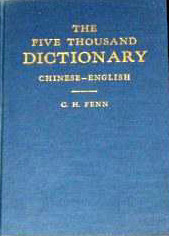 W
WThe Five Thousand Dictionary: A Chinese-English Dictionary… (1926) or Fenn's Chinese-English Pocket-Dictionary (1942), which was compiled by American missionary Courtenay H. Fenn, is a widely reprinted learners' dictionary that selected Chinese character entries on the basis of common usage. It was the first Chinese-English dictionary to indicate the neutral tone associated with weak syllables.
 W
WXiandai Hanyu Cidian, also known as A Dictionary of Current Chinese or Contemporary Chinese Dictionary is an important one-volume dictionary of Standard Mandarin Chinese published by the Commercial Press, now into its 7th (2016) edition. It was originally edited by Lü Shuxiang and Ding Shengshu as a reference work on modern Standard Mandarin Chinese. Compilation started in 1958 and trial editions were issued in 1960 and 1965, with a number of copies printed in 1973 for internal circulation and comments, but due to the Cultural Revolution the final draft was not completed until the end of 1977, and the first formal edition was not published until December 1978. It was the first People's Republic of China dictionary to be arranged according to Hanyu Pinyin, the phonetic standard for Standard Mandarin Chinese, with explanatory notes in simplified Chinese. The subsequent second through seventh editions were respectively published in 1983, 1996, 2002, 2005, 2012 and 2016.
 W
WXiandai Hanyu Guifan Cidian is a dictionary of Standard Chinese created as part of proposal in the Eighth Five-year Plan of China. It is similar to Xiandai Hanyu Cidian, but with notable divergences. The third edition has entries for 12,000 characters and 72,000 words, with over 80,000 example usages.
 W
WThe Xinhua Zidian, or Xinhua Dictionary, is a Chinese language dictionary published by the Commercial Press. It is the best-selling Chinese dictionary and the world's most popular reference work. In 2016, Guinness World Records officially confirmed that the dictionary, published by The Commercial Press, is the "Most popular dictionary" and the "Best-selling book ". It is considered a symbol of Chinese culture.
 W
WThe Yiqiejing yinyi 一切經音義 "Pronunciation and Meaning in the Complete Buddhist Canon" was compiled by the Tang dynasty lexicographer monk Huilin 慧琳 as an expanded revision of the original Yiqiejing yinyi compiled by Xuanying 玄應. Collectively, Xuanying's 25-chapter and Huilin's 100-chapter versions constitute the oldest surviving Chinese dictionary of Buddhist technical terminology. A recent history of Chinese lexicography call Huilin's Yiqiejing yinyi "a composite collection of all the glossaries of scripture words and expressions compiled in and before the Tang Dynasty" and "the archetype of the Chinese bilingual dictionary".
 W
WThe Yiqiejing yinyi 一切經音義 "Pronunciation and Meaning in the Complete Buddhist Canon" is the oldest surviving Chinese dictionary of Buddhist technical terminology, and was the archetype for later Chinese bilingual dictionaries. This specialized glossary was compiled by the Tang dynasty lexicographer monk Xuanying 玄應, who was a translator for the famous pilgrim and Sanskritist monk Xuanzang. When Xuanying died he had only finished 25 chapters of the dictionary, but another Tang monk Huilin 慧琳 compiled an enlarged 100-chapter version with the same title, the (807) Yiqiejing yinyi.
 W
WThe Yunhai jingyuan 韻海鏡源 Ocean of Rhymes, Mirror of Sources Chinese dictionary, which was compiled by the Tang dynasty official and calligrapher Yan Zhengqing (709–785), was the first phonologically-arranged rime dictionary of words rather than characters. Although the Yunhai jingyuan is a lost work, several later dictionaries, such as the (1711) Peiwen Yunfu, followed its system of collating entries by the tone and rime of the last character in a term.
 W
WThe Yunjing is one of the two oldest existing examples of a Chinese rhyme table – a series of charts which arrange Chinese characters in large tables according to their tone and syllable structures to indicate their proper pronunciations. Current versions of the Yunjing date to AD 1161 and 1203 editions published by Zhang Linzhi (張麟之). The original author(s) and date of composition of the Yunjing are unknown. Some of its elements, such as certain choices in its ordering, reflect features particular to the Tang dynasty, but no conclusive proof of an actual date of composition has yet been found.
 W
WThe Yupian is a c. 543 Chinese dictionary edited by Gu Yewang during the Liang dynasty. It arranges 12,158 character entries under 542 radicals, which differ somewhat from the original 540 in the Shuowen Jiezi. Each character entry gives a fanqie pronunciation gloss and a definition, with occasional annotation.
 W
WThe Zhonghua Da Zidian is an unabridged Chinese dictionary of characters, originally published in 1915 by the Zhonghua Book Company in Shanghai. The chief editors were Xu Yuan'gao (徐元誥), Lufei Kui (陆费逵), and Ouyang Pucun (歐陽溥存/欧阳溥存). It was based upon the 1716 Kangxi Zidian, and is internally organized using the 214 Kangxi radicals. The 1915 publication contains more than 48,000 entries for individual characters, including many invented in the two centuries since the Kangxi Dictionary, making it the largest character dictionary of its time.
 W
WThe 1615 Zìhuì is a Chinese dictionary edited by the Ming Dynasty scholar Mei Yingzuo (梅膺祚). It is renowned for introducing two lexicographical innovations that continue to be used in the present day: the 214-radical system for indexing Chinese characters, which replaced the classic Shuowen Jiezi dictionary's 540-radical system, and the radical-and-stroke sorting method.
 W
WThe (1254) Zitong 字通 or Mastery of Characters is a Chinese dictionary of orthography that was compiled by the Southern Song dynasty (1127-1279) scholar Li Congzhou 李從周. It discussed logographic differences among Chinese characters written in the ancient Qin dynasty seal script, standard Han dynasty clerical script, and contemporary Song regular script.